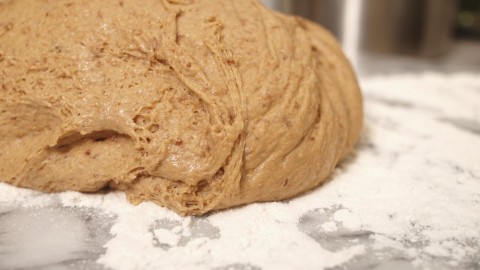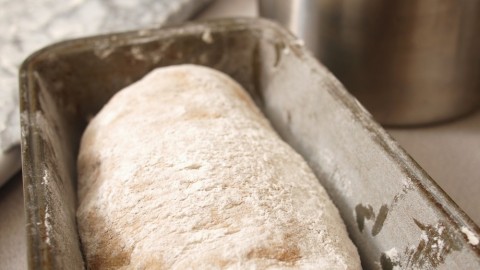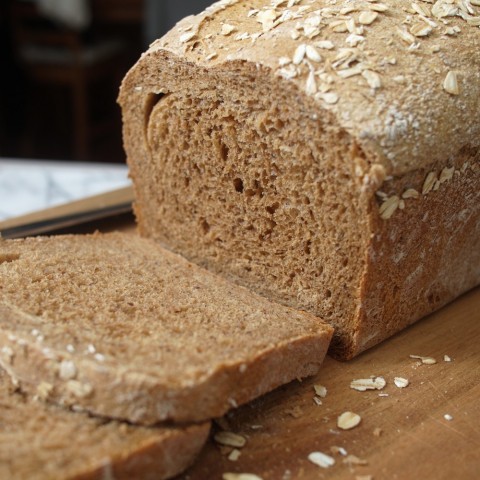Bread is really important.
The English word companionship derives from a Latin compound — cum and panis — meaning with bread. The word that we use to describe pay for work, salary, also comes from Latin — from salis, meaning salt. But when we’re trying to be cool, or casual, or colloquial (the three c’s!), we might tell people that we’ve made some dough this week — or that we’ve made some bread.
For a large swath of the population, Sunday mornings are all about getting up, jumping into one’s best clothes, and heading to church to ask for bread. Forgive us our tresspasses, Christians intone (though some intone debts, instead), and give us this day our daily bread.
And at the beginning of meals, when it comes time to bless the food, it is bread, specifically, for which Jews thank God (המוציא לחם מן הארץ).
So important is bread, in fact, that folks way back at the beginnings of civilization decided that, along with beer, it was the thing that most signified being a civilized person. In The Epic of Gilgamesh, which is more than 4,000 years old and among the earliest pieces of written literature we have, the character Enkidu is an unshorn, unbathed wildman who makes his home with a herd of gazelles until he encounters bread:
Bread they set before him,
ale they set before him.
Enkidu ate not the bread, but looked askance.
How to eat bread, Enkidu knew not,
how to drink ale he had to be shown.
But when those folks show Enkidu how to eat and how to drink, everything changes.
Enkidu at the bread until he was sated,
he drank the ale, a full seven goblets.
His mood became free, he started to sing,
his heart grew merry, his face lit up.*
Song, here, is a facet of civilized life — not a life of roaming with beasts in the wild. Singing and drinking are communal activities, things one only does among companions of the human persuasion. For Enkidu, there are of course other markers of civilization: sex, haircuts, clothes, and weapons. But bread is essential to his transformation from wilderness vagrancy to a new life in cosmopolitan Uruk.

The thing that’s special about bread, that makes it a civilizing influence, is that it’s ultimately a processed food.
To make bread, you need flour, and flour doesn’t grow on trees. It requires knowing how to cultivate grain; it requires knowing how to harvest it, winnow it, and make the machinery to mill it into dust.
To make bread, you need ovens, and ovens don’t pop up like geological formations. They require that you know how to hew stone, how to fit it together with mortar, use it to contain fire’s heat, and make and sustain fire in the first place.
Bread doesn’t make sense if you’re out on your own. For the work it takes to make a daily loaf of bread, you could much more effectively hunt and gather your way across a forest or savanna, eating nuts, leaves, and fruit, and all sorts of things that are much more obviously food than wheat.
Bread really only makes sense in the context of companionship and community, where folks have specialized knowledge, where they can divide labor, and where a few people can make enough food to nourish everybody, so that the rest can have time for other pursuits like building and defending a town.
Which brings me to this week’s experiment. This bread is a simple loaf, a quotidian loaf, the sort of loaf one makes to eat, rather than to push the limits of one’s skill at baking. One of the deficiencies that I’ve found in lots of food blogs, this one included, is that when it comes to bread, it’s all about the flash, the showy freeform boules and batards, baguettes and ciabatta-esque slippers.
But while artisan, rustic, high-hydration loaves can indeed be a very pretty sight, and while open crumb and crispy crust is delicious dipped in olive oil or spread with a triple-cream brie, these aren’t the breads of subsistence.
Sometimes what you need is to balance slices of meat and tomato between slices of bread — to make leftovers into a filling meal that doesn’t require the extensive use of utensils. Sometimes what you need a hardy palette on which to spread your organic hand-crank peanut butter and homemade jam.
Fancy breads are great, dear readers, and the height of civilization. But sometimes, the companionship of a whole wheat sandwich loaf is utterly indispensable.
For the Sponge:
150 grams Whole Wheat Flour
300 grams Filtered Water
1 tsp Rapid Rise Yeast
For the Dough:
300 grams Unbleached AP White Flour
150 grams Whole Wheat Flour
120 grams Filtered Water
1/4 cup Flax Seed
2 tbsp Molasses
2 tsp Salt
Rolled Oats
Vegetable Oil
The night before: In the workbowl of a stand mixer, combine the whole wheat flour, water, and yeast. Whisk briefly by hand, cover, and allow the sponge to stand overnight.
The day of: To the workbowl with the sponge, add the remainder of the ingredients for the dough. Use the dough-hook attachment to mix the ingredients on the lowest setting of the stand mixer. Then, when all the ingredients are combined, raise the speed to low-medium (I use setting number four on my KitchenAid) and knead for 5-7 minutes, or until the dough springs firmly back when pressed.
Form the dough into a tight ball, deposit it in an oiled bowl, cover, and allow it to rise for about three hours, or until it has more than doubled in size.
Grease and flour a bread pan.
When the first rise is complete, scrape the dough out of the bowl, onto a floured counter or pastry board. Gently spread it into a rectangle, then roll it into a cigar shape, being careful to maintain its surface tension. Deposit your formed loaf seam-side down into the bread pan. Loosely cover with a moist towel, preheat your oven to 375F, and allow the dough to proof for about an hour.
At the end of its second rise, use a serrated knife to score the loaf, about half an inch deep, down its midline. Spray its surface with a little bit of water, and then sprinkle a handful of rolled oats over the top. Turn the oven temperature down to 350F, and bake the loaf for 50 minutes.
When it is done, remove the loaf from the oven and allow it to stand for about ten minutes. Then extract it from its bread pan (turning it over and banging the bottom usually does the trick), place on a rack, and allow the loaf to cool completely before slicing and serving.
* The translation that I’m using here is a by Andrew George. I’ve read a few translations of The Epic of Gilgamesh in my time, and this one is by far the most beautiful. Highly recommended!





